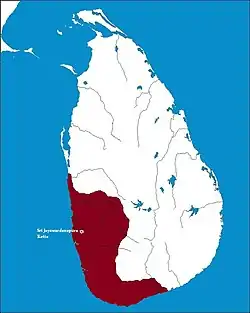Kingdom of Kotte
Template:Sri Lankan former states
.png.webp)
Map of Sri Jayawardenepura Kotte (1557 -1565)
Kingdom of Kotte කෝට්ටේ රාජධානිය Sri Lanka | |||||||||
|---|---|---|---|---|---|---|---|---|---|
| 1412–1597 | |||||||||
 Flag | |||||||||
 Kingdom of Kotte (1505) | |||||||||
.jpg.webp) The Kingdom of Kotte in 1467 AD at its greatest extent, the time of Parakramabahu VI's death | |||||||||
| Capital | Sri Jayawardenepura Kotte | ||||||||
| Common languages | Sinhalese, Tamil | ||||||||
| Religion | Theravada Buddhism | ||||||||
| Government | Monarchy | ||||||||
| Kingdom of Kotte | |||||||||
• 1412–1467 | Parakramabahu VI of Kotte | ||||||||
• 1472-1480 | Bhuvanaikabahu VI of Kotte | ||||||||
• 1484-1518 | Parakramabahu VIII of Kotte | ||||||||
• 1551–1597 | Dharmapala of Kotte (Last) | ||||||||
| History | |||||||||
• Unification of all Sri Lanka | 1412 | ||||||||
• Disestablished | 1597 | ||||||||
| |||||||||
The Kingdom of Kotte (Sinhala: කෝට්ටේ රාජධානිය Kottay Rajadhaniya), centered on Sri Jayawardenepura Kotte , was a kingdom that flourished in Sri Lanka during the 15th century.
History
Parakramabahu VI first became the king of Raigama in 1412, then in 1415 he made Sri Jayawardenepura Kotte his capital. The King upgraded the existing citadel and built a new royal palace. Parakramabahu VI waited until ties between the Vijayanagara Empire and Jaffna Kingdom were severed. First he captured the Vanni and made its leaders loyal to him. Sapumal Kumaraya was the commander of the Kotte army at the time. Tamil served as one of the court languages of the Kotte kingdom at this time.[1]
References
This article is issued from Wikipedia. The text is licensed under Creative Commons - Attribution - Sharealike. Additional terms may apply for the media files.